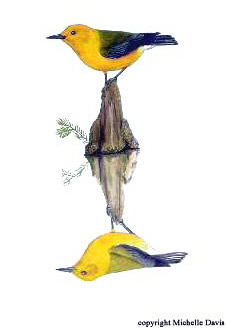| |
Frank
retired in 2016 and the Migratory Bird Research Group has dispersed over the years, yet this website continues to provide information about the work of the group, notably the ecology,
behavior and ecophysiology of migratory songbirds during passage.
My
students, collaborators and I integrated field and laboratory approaches to study the response of migrants to challenges that can arise during
stopover and how events during passage are interconnected with other phases of the annual cycle. Why migrating birds stopover determines in large measure what they do during stopover: A
migrant may be low on fuel stores, off course and find it easier to correct and reorient while on the ground, fatigued and in need of rest and
sleep after flying long hours or against unfavorable winds, experiencing or anticipating inclement weather, out of nighttime as a nocturnal migrant, or maybe the endogenous time
– direction program simply dictates a pause en
route to destination.
 Our first long
term study site was established in the mid-1980s at Peveto Woods and later moved to Johnsons Bayou, both part of a chenier
(coastal woodland) in Cameron Parish, Louisiana. We did so with the help of my doctoral mentor, Sidney Gauthreaux, Jr, and
the Baton Rouge Audubon Society. Radar ornithology studies later confirmed what birders knew for years, namely that southwest
Louisiana consistently experiences some of the highest density of spring migration along the northern coast of the Gulf of Mexico. It was
in Peveto Woods that I experienced my first "fallout" of trans-gulf migrants. A short time later, we established another long term
migration station on Ft. Morgan Peninsula, AL (1990 – 2015). Over the years, we studied bird migration at sites across North America as
well as Sweden, Italy and Honduras.
Our first long
term study site was established in the mid-1980s at Peveto Woods and later moved to Johnsons Bayou, both part of a chenier
(coastal woodland) in Cameron Parish, Louisiana. We did so with the help of my doctoral mentor, Sidney Gauthreaux, Jr, and
the Baton Rouge Audubon Society. Radar ornithology studies later confirmed what birders knew for years, namely that southwest
Louisiana consistently experiences some of the highest density of spring migration along the northern coast of the Gulf of Mexico. It was
in Peveto Woods that I experienced my first "fallout" of trans-gulf migrants. A short time later, we established another long term
migration station on Ft. Morgan Peninsula, AL (1990 – 2015). Over the years, we studied bird migration at sites across North America as
well as Sweden, Italy and Honduras.
Last modified: 12 December 2023
Questions and Comments?
URL: http://sites.usm.edu/migratory-bird-research/index.html
The University of Southern Mississippi | 118 College Drive, Hattiesburg, MS 39406-0001
601.266.1000 | EEO Statement
© 2019 The University of Southern Mississippi. All rights reserved.
|
